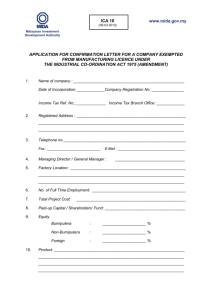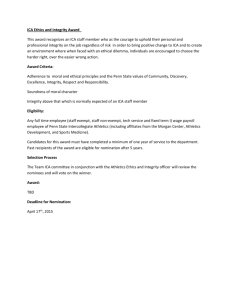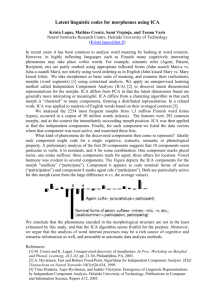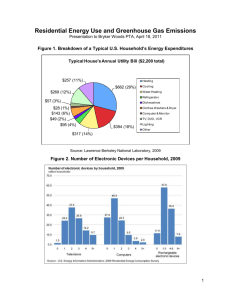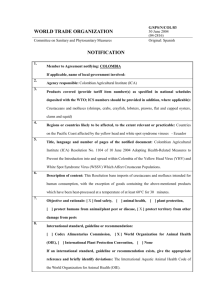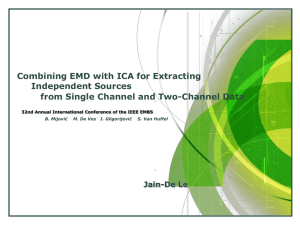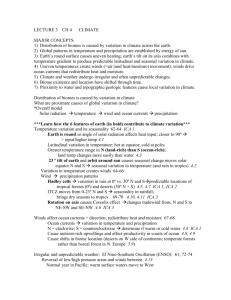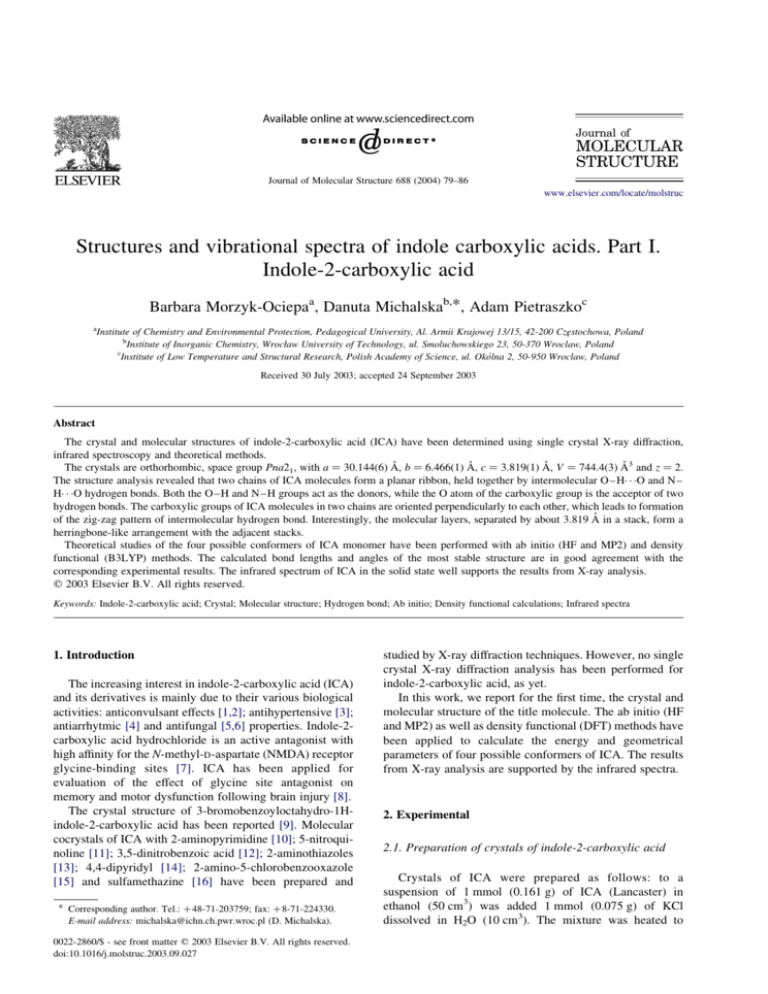
Journal of Molecular Structure 688 (2004) 79–86
www.elsevier.com/locate/molstruc
Structures and vibrational spectra of indole carboxylic acids. Part I.
Indole-2-carboxylic acid
Barbara Morzyk-Ociepaa, Danuta Michalskab,*, Adam Pietraszkoc
a
Institute of Chemistry and Environmental Protection, Pedagogical University, Al. Armii Krajowej 13/15, 42-200 Cze˛stochowa, Poland
b
Institute of Inorganic Chemistry, Wrocław University of Technology, ul. Smoluchowskiego 23, 50-370 Wroclaw, Poland
c
Institute of Low Temperature and Structural Research, Polish Academy of Science, ul. Okólna 2, 50-950 Wroclaw, Poland
Received 30 July 2003; accepted 24 September 2003
Abstract
The crystal and molecular structures of indole-2-carboxylic acid (ICA) have been determined using single crystal X-ray diffraction,
infrared spectroscopy and theoretical methods.
The crystals are orthorhombic, space group Pna21, with a ¼ 30:144ð6Þ Å, b ¼ 6:466ð1Þ Å, c ¼ 3:819ð1Þ Å, V ¼ 744:4ð3Þ Å3 and z ¼ 2:
The structure analysis revealed that two chains of ICA molecules form a planar ribbon, held together by intermolecular O – H· · ·O and N–
H· · ·O hydrogen bonds. Both the O – H and N – H groups act as the donors, while the O atom of the carboxylic group is the acceptor of two
hydrogen bonds. The carboxylic groups of ICA molecules in two chains are oriented perpendicularly to each other, which leads to formation
of the zig-zag pattern of intermolecular hydrogen bond. Interestingly, the molecular layers, separated by about 3.819 Å in a stack, form a
herringbone-like arrangement with the adjacent stacks.
Theoretical studies of the four possible conformers of ICA monomer have been performed with ab initio (HF and MP2) and density
functional (B3LYP) methods. The calculated bond lengths and angles of the most stable structure are in good agreement with the
corresponding experimental results. The infrared spectrum of ICA in the solid state well supports the results from X-ray analysis.
q 2003 Elsevier B.V. All rights reserved.
Keywords: Indole-2-carboxylic acid; Crystal; Molecular structure; Hydrogen bond; Ab initio; Density functional calculations; Infrared spectra
1. Introduction
The increasing interest in indole-2-carboxylic acid (ICA)
and its derivatives is mainly due to their various biological
activities: anticonvulsant effects [1,2]; antihypertensive [3];
antiarrhytmic [4] and antifungal [5,6] properties. Indole-2carboxylic acid hydrochloride is an active antagonist with
high affinity for the N-methyl-D -aspartate (NMDA) receptor
glycine-binding sites [7]. ICA has been applied for
evaluation of the effect of glycine site antagonist on
memory and motor dysfunction following brain injury [8].
The crystal structure of 3-bromobenzoyloctahydro-1Hindole-2-carboxylic acid has been reported [9]. Molecular
cocrystals of ICA with 2-aminopyrimidine [10]; 5-nitroquinoline [11]; 3,5-dinitrobenzoic acid [12]; 2-aminothiazoles
[13]; 4,4-dipyridyl [14]; 2-amino-5-chlorobenzooxazole
[15] and sulfamethazine [16] have been prepared and
* Corresponding author. Tel.: þ 48-71-203759; fax: þ 8-71-224330.
E-mail address: michalska@ichn.ch.pwr.wroc.pl (D. Michalska).
0022-2860/$ - see front matter q 2003 Elsevier B.V. All rights reserved.
doi:10.1016/j.molstruc.2003.09.027
studied by X-ray diffraction techniques. However, no single
crystal X-ray diffraction analysis has been performed for
indole-2-carboxylic acid, as yet.
In this work, we report for the first time, the crystal and
molecular structure of the title molecule. The ab initio (HF
and MP2) as well as density functional (DFT) methods have
been applied to calculate the energy and geometrical
parameters of four possible conformers of ICA. The results
from X-ray analysis are supported by the infrared spectra.
2. Experimental
2.1. Preparation of crystals of indole-2-carboxylic acid
Crystals of ICA were prepared as follows: to a
suspension of 1 mmol (0.161 g) of ICA (Lancaster) in
ethanol (50 cm3) was added 1 mmol (0.075 g) of KCl
dissolved in H2O (10 cm3). The mixture was heated to
80
B. Morzyk-Ociepa et al. / Journal of Molecular Structure 688 (2004) 79–86
Table 1
Crystal data and structure refinement for indole-2-carboxylic acid (ICA)
Empirical formula
Formula weight
Temperature (K)
Crystal system
Space group
Unit cell dimensions (Å)
Volume (Å3)
Z (molecule/cell)
Density calculated (Mg m23)
Crystal size (mm)
Absorption coefficient (mm21)
Fð000Þ
Theta range for data collection (8)
Reflections collected/unique
Independent reflections
Data/restraints/parameters
Goodness-of-fit on F 2
Final R indices ½I . 2sigmaðIÞ
R indices (all data)
C9H7NO2
161.15
293(2)
Orthorhombic
Pna21
a ¼ 30:144ð6Þ
b ¼ 6:466ð1Þ
c ¼ 3:819ð1Þ
744.4(3)
4
1.438
0.28 £ 0.21 £ 0.19
0.103
336
4.62–26.0
6272/1392 ½RðintÞ ¼ 0:0644
1392
1392/1/138
0.899
R1 ¼ 0:0414; wR2 ¼ 0:0635
R1 ¼ 0:0743; wR2 ¼ 0:0741
240 K until ICA dissolved completely. After a week,
yellow-crystals of ICA were formed.
2.2. X-ray analysis
The X-ray diffraction data were collected using an
automatic X-ray four-circle EXCALIBUR single crystal
diffractometer with CCD area detectors. Graphite monochromated Mo Ka radiation (l ¼ 0:071073 nm) was generated at 50 kV and 25 mA. A single image for 18 rotation
around the v-axis was obtained during 30 s and the full set
of X-ray diffraction was collected in the u angle over the
range from 4.62 to 26.08. The intensities of the reflections
were recorded in 900 frames (each frame consisting of
512 £ 512 pixels with 2 £ 2 pixels binning). The lattice
parameters were calculated from refinement of positions of
all measured reflections. The data were corrected for
Lorentz and polarization effects. No absorption correction
was applied. The structure was solved by direct methods
(program SHELXS-97 [17] and refined by the full-matrix
least-squares method based on F 2 using SHELXL-97 [18].
All non-hydrogen atoms were refined anisotropically by
unit-weighted full-matrix least-square methods. Hydrogen
atoms were included from the difference Fourier Dr maps
and refined with isotropic thermal parameters. Several
cycles of refinement reduced the R value to 0.041 and wR2
to 0.063 for 1392 independent reflections.
The crystal data together with the refinement details are
given in Table 1.
2.3. Infrared measurements
The FT-infrared spectrum of solid ICA in the region
4000– 400 cm21 was measured on a Nicolet-Nexus spectrometer using the KBr pellets.
2.4. Theoretical methods
Calculations were performed by the HF and MP2
methods and B3LYP functional [19,20]. Two basis sets
were employed: 6-311þ þ G(df,p), in HF method, and 6311þ þ G(d,p) [21,22] in B3LYP and MP2 methods. All
calculations were carried out with the Gaussian 98 package
[23].
3. Results and discussion
3.1. Theoretical studies on the conformers of indole-2carboxylic acid
Full optimization of geometry has been performed for
four possible ICA conformers, which differ in the relative
orientation of atoms in the carboxylic group, as shown in
Fig. 1. Structure I (in which the OH group is in the anti-
Fig. 1. Relative differences in energy ðDEÞ between four conformers of ICA. The minimum energy values (in kcal mol21) are as follows: 2344665.1 (HF);
2346734.3 (B3LYP) and 2345776.4 (MP2).
B. Morzyk-Ociepa et al. / Journal of Molecular Structure 688 (2004) 79–86
81
Table 2
The selected bond lengths (Å) and bond angles (8), with e.s.d.s. in
parentheses, determined for ICA by X-ray diffraction and the corresponding
theoretical parameters, calculated for conformer I by the HF, B3LYP and
MP2 methods
Exp.
Fig. 2. Overall view of indole-2-carboxylic acid (ICA) with atom labeling.
position to the N –H group) is the most stable, as revealed by
calculations at the HF, MP2 and DFT(B3LYP) levels of
theory. Conformer II is slightly higher in energy, by about
1.1 –1.4 kcal mol21. In this isomer, the COOH group has
rotated (by 1808), in comparison to I. Remaining conformers, III and IV are higher in energy, by about
5 kcal mol21. Subsequent calculations of vibrational frequencies have revealed that both I and II are stable, in the
gas phase.
3.2. Description of the structure
The overall view of ICA molecule with atom labeling is
shown in Fig. 2. The single crystal X-ray diffraction study
indicates the presence of conformer I in crystal. Selected
bond lengths and angles are listed in Table 2, along with the
corresponding theoretical values calculated by the HF, MP2
and B3LYP methods. It should be noted that the calculations
have been performed for an isolated ICA molecule, in the
gas phase, but agreement between the theoretical and
experimental results is quite good. Some deviations from
the experimentally observed values can be attributed to
hydrogen bonds in the solid state.
As follows from Table 2, the C0 – O1 bond length of
1.227(1) Å is slightly longer than the theoretical values, and
this is caused by intermolecular hydrogen bonding in
crystal. It should be emphasized that the calculated bond
angles show very good agreement with experimental data.
For example, the B3LYP-predicted angles: O1 –C0 – O2
(122.98) and O2 – C0 – C1 (113.18) agree well with experimental, 121.6(1) and 112.5(1)8, respectively. Several bond
angles, e.g. N1 –C1 – C2 (109.48) are almost reproduced by
the B3LYP calculation, as shown in Table 2.
The biggest deviation between the calculated and
experimental bond angle is noted for the C0 –O2 – H11
group. This is attributed to intermolecular hydrogen
bonding in the crystal of ICA, which leads to an increase
(opening) of the C0 – O2 – H11 angle, by about 108, in
comparison with the theoretical value of the isolated
monomer.
O(1) –C(0)
O(2) –C(0)
O(2) –H(11)
C(0)–C(1)
C(1)–C(2)
C(1)–N(1)
C(2)–C(3)
C(2)–H(1)
C(3)–C(8)
C(3)–C(4)
C(4)–C(5)
C(4)–H(4)
C(5)–C(6)
C(5)–H(5)
C(6)–C(7)
C(6)–H(6)
C(7)–C(8)
C(7)–H(7)
C(8)–N(1)
N(1) –H(2)
O(1) –C(0)–O(2)
O(1) –C(0)–C(1)
O(2) –C(0)–C(1)
C(0)–O(2) –H(11)
C(0)–C(1) –N(1)
N(1) –C(1)–C(2)
C(1)–C(2) –C(3)
C(1)–C(2) –H(1)
C(2)–C(3) –C(8)
C(2)–C(3) –C(4)
C(3)–C(4) –C(5)
C(3)–C(4) –H(4)
C(4)–C(5) –C(6)
C(4)–C(5) –H(5)
C(5)–C(6) –C(7)
C(5)–C(6) –H(6)
C(6)–C(7) –C(8)
C(6)–C(7) –H(7)
C(7)–C(8) –C(3)
C(7)–C(8) –N(1)
C(8)–N(1) –C(1)
C(1)–N(1) –H(2)
1.227(1)
1.326(1)
0.951(11)
1.439(1)
1.369(1)
1.384(1)
1.416(2)
0.932(9)
1.403(1)
1.409(2)
1.357(2)
0.974(8)
1.404(2)
0.964(8)
1.372(2)
1.026(11)
1.390(2)
1.045(10)
1.383(1)
0.968(11)
121.6(1)
125.9(1)
112.5(1)
116.0(6)
121.8(1)
109.4(1)
107.6(1)
125.3(6)
106.9(1)
134.2(1)
118.7(1)
117.0(5)
121.4(1)
121.2(5)
121.5(1)
117.7(6)
117.2(1)
122.6(6)
122.2(1)
129.6(1)
107.9(1)
122.9(7)
HF
1.187
1.332
0.945
1.467
1.352
1.371
1.432
1.070
1.400
1.401
1.368
1.076
1.409
1.075
1.368
1.075
1.398
1.075
1.359
0.992
123.1
123.5
113.4
108.9
119.0
110.1
106.5
125.8
106.7
133.8
118.9
120.4
120.8
120.1
121.7
119.0
117.4
121.2
121.8
130.2
108.7
126.0
B3LYP
1.214
1.354
0.968
1.459
1.378
1.384
1.427
1.078
1.426
1.408
1.383
1.084
1.413
1.084
1.385
1.084
1.400
1.084
1.371
1.008
122.9
124.0
113.1
106.9
118.6
109.4
106.9
125.3
107.0
134.0
118.9
120.4
121.1
119.8
121.6
119.2
117.4
121.2
122.0
130.6
109.2
123.1
MP2
1.218
1.352
0.969
1.464
1.390
1.376
1.427
1.082
1.430
1.414
1.389
1.087
1.418
1.087
1.391
1.087
1.404
1.087
1.373
1.012
123.7
123.7
112.6
105.9
118.3
109.6
106.5
125.3
107.1
134.0
118.7
120.4
121.4
119.6
121.4
119.3
117.2
121.2
122.3
130.3
109.4
123.1
According to the X-ray results, the conjugated sixmembered and five-membered rings of indole part are
nearly coplanar, for example, the C2 – C3 –C8 – C7 torsional
angle is 179.0(1)8, and N1 –C1 – C2 – C3 torsional angle is
nearly zero (0.1(1)8). The carboxylic group of ICA shows
only a small distortion from the molecular plane: the
dihedral angle between the best least-squares planes formed
by the indole ring atoms (C1, C2, C3, C4, C5, C6, C7, C8
and N1) plane I, and the carboxylic group atoms (C0, O1
and O2) plane II, is 2.98(0.13)8.
Comparison of the X-ray data of ICA (this work) and
those of the parent indole [24] indicates that the presence of
82
B. Morzyk-Ociepa et al. / Journal of Molecular Structure 688 (2004) 79–86
Table 3
Hydrogen bonds distances (Å) and angles (8) in ICA
D –H· · ·A
D –H
H· · ·A
D· · ·A
/D–H· · ·A
O(2) –H(11)· · ·O(1)i
N(1) –H(2)· · ·O(1)ii
0.951(11)
0.969(11)
1.749(11)
2.172(11)
2.659(1)
3.118(1)
159.2(10)
165.3(10)
Symmetry transformations used to generate equivalent atoms: (i) 2x þ
3=2; y þ 1=2; z þ 1=2; (ii) 2x þ 3=2; y 2 1=2; z 2 1=2:
the carboxylic group affects the bond lengths and angles in
the conjugated rings. For example, in ICA, the N1 –C1 and
N1 – C8 bond lengths are longer (1.384(1) and 1.383(1) Å,
respectively) than in indole (1.370 Å). On the other hand,
both the C3 – C4 and C4 – C5 bonds in ICA (1.409(2) and
1.357(2) Å, respectively) are shorter than the corresponding
bands in indole molecule (1.425 and 1.382 Å). It should also
be noted that in ICA, the C3 – C8 bond length (1.403(1) Å) is
elongated, in comparison to indole (1.382 Å) [24].
Hydrogen bond lengths and bond angles of ICA are
shown in Table 3. Fig. 3 illustrates the H-bond pattern in
the crystal. The planar ribbon consists of two chains of
molecules held together by intermolecular hydrogen
bonds. It should be emphasized that the pattern of the
intermolecular hydrogen bonding is different than that
observed in typical cyclic carboxylic acid dimers. It is
seen that the carboxylic group of the ICA molecule in
one chain is facing almost perpendicularly to the
direction of the carboxylic group in the other chain.
This is caused by the fact that ICA contains two
hydrogen-bond donor sites, the carboxylic O2 –H and
indole N1 –H groups which point toward an approximately orthogonal directions. Both the O2 – H11 and N1 –
H2 groups act as donor sites, while the O1 atom acts as
the acceptor site for two hydrogen bonds, as shown in
Table 3 and in Fig. 3. Of the two hydrogen bonds, O2 –
H11· · ·(O1)i (i: 2x þ 3=2; y þ 1=2; z þ 1=2) and N1 –
H2· · ·(O1)ii (ii: 2x þ 3=2; y 2 1=2; z 2 1=2) with the
D· · ·A distances of 2.659 and 3.118 Å, and /D –H· · ·A
angles of 159.2 and 165.38, respectively, the former is of
a moderate strength, while the latter (N –H· · ·O) is much
weaker. Interestingly, these hydrogen bonds form the
nine-membered rings, which share the common C0 –O1
bond. This leads to a zig-zag structure of the H-bonded
rings.
Fig. 4 shows the packing arrangement of the
molecules in the unit cell, viewed down c-axis. The
ribbons containing the nine-membered hydrogen bonded
zigzag rings are running along the b-axis.
Fig. 5 shows the projection of the crystal structure on
the 011 plane. It is interesting that the parallel layers
consisting of molecular ribbons in one stack (column) are
in a skew orientation with respect to the layers in the
adjacent stacks. It should be noted that the carboxylic
oxygen atoms in one layer are positioned above (or
below) the oxygen atoms in the neighboring layers. Such
an arrangement increases repulsion between the lone
electron pairs of the oxygen atoms in the parallel layers,
which decreases p – p stacking interaction between the
aromatic rings in the neighboring layers. Consequently,
these effects increase the distance between the parallel
layers, to 3.819 Å.
Fig. 3. The hydrogen bonding pattern in ICA (H-bonds are indicated by dashed lines).
B. Morzyk-Ociepa et al. / Journal of Molecular Structure 688 (2004) 79–86
83
Fig. 4. The arrangement of the ICA molecules in the unit cell, viewed down c-axis.
Fig. 6 shows the projection of ICA crystal down the aaxis. It is seen that the planar layers form a herringbone-like
arrangement between the adjacent stack. The torsion angle
between the two adjacent stacks (determined as the angle
between the normals to planes defined by indole rings of
ICA molecules, in adjacent stacks) is equal to 49.58. This is
a measure of the twist of ICA molecules in one stack with
respect to those in an adjacent stack. It should be mentioned
that very recently, a similar packing arrangement has been
reported for 1,2,4,5-tetrazines [25].
3.3. Infrared spectrum
The infrared spectrum of indole-2-carboxylic acid in the
solid state (KBr pellets) is shown in Fig. 7. Recently, Tine
et al. [26] studied the infrared spectrum of ICA, assuming
that the two molecules form cyclic dimer associated by two
O – H· · ·O hydrogen bonds, typical of carboxylic acid
dimers, while the N – H group of ICA is not involved in
hydrogen bonding. As we have shown in this work, the
structure assumed by those authors was incorrect, since both
the O –H and N – H groups of ICA (oriented in nearly
orthogonal directions) act as the donors of hydrogen bonds.
The strong band in the IR spectrum of ICA, at
3350 cm21, can be assigned to nðN – HÞ stretching vibration
of the molecules associated by intermolecular N – H· · ·O
hydrogen bond. In addition, a small satellite band is
observed at 3453 cm21. Most probably, the latter band
arises from the non-associated, end N –H groups of the ICA
chains in the crystal.
A strong and very broad band occurring between 3200
and 2000 cm21 is due to the nðO – HÞ stretching mode of the
OH group involved in intermolecular O –H· · ·O hydrogen
bond. Significant lowering and broadening of the nðO – HÞ
band indicates that the O – H· · ·O hydrogen bond is stronger
than N –H· · ·O hydrogen bond, which is confirmed by the
X-ray data of ICA.
The very strong band at 1707 cm21 is assigned to the
nðCyOÞ stretching vibration. The frequency of this vibration
is slightly lower than the frequency of the non-associated
carboxylic CyO group in 9,10-dihydro-9-oxo-10-acridineacetic acid (1737 cm21) [27]. This supports the conclusion
that in the crystal of ICA, the CyO group participates in
intermolecular hydrogen bonding. It should also be noted,
that the CyO bond arising from the cyclic dimer of acetic
acid was observed at 1681.5 cm21, in the gaseous state [28].
In the IR spectrum of ICA, the strongest band
appearing at 1194 cm21 can be assigned to the nðC – OÞ
stretching vibration in the carboxylic group. Thus, the
large difference between the frequencies of nðCyOÞ and
nðC – OÞ stretching vibrations of the carboxylic group
excludes the possibility of the existence of deprotonated
B. Morzyk-Ociepa et al. / Journal of Molecular Structure 688 (2004) 79–86
Fig. 5. Projection of the crystal structure of ICA on the 011 plane.
84
B. Morzyk-Ociepa et al. / Journal of Molecular Structure 688 (2004) 79–86
85
Fig. 6. Projection of the crystal structure of ICA along the a-axis.
Fig. 7. The infrared spectrum of indole-2-carboxylic acid.
ICA in crystal. In should be noted that in the IR
spectrum of sodium indole-2-carboxylate (in solid state),
two strong bands at 1562 and 1409 cm21 were assigned
to asymmetric na ðCOO2 Þ and symmetric ns ðCOO2 Þ
stretching vibrations, respectively [26].
The presented assignment of the characteristic vibrations
of ICA in the IR spectrum provides additional evidence for
the structure and hydrogen bonding determined by the X-ray
method. This assignment can be useful in further studies of
complexes of indolecarboxylic acids with metal ions, by
vibrational spectroscopic methods.
Acknowledgements
The authors are grateful to the Wroclaw Supercomputer
and Networking Center for a generous computer time.
Supporting Information
The crystallographic data of the title compound in CIF
electronic format are available at http://www.rscorg/
supdata/CCDC216179.
86
B. Morzyk-Ociepa et al. / Journal of Molecular Structure 688 (2004) 79–86
References
[1] A.C. Nichols, K.L. Yielding, Mol. Chem. Neuropathol. 19 (1993) 269.
[2] M. Mugnaini, M. Antolini, M. Corsi, F.T. Vanamsterdam, J. Recept.
Signal Transduct. Res. 18 (1998) 91.
[3] S. Nagata, K. Takeyama, F. Fukuya, R. Nagai, K. Hosoki, K.
Nishimura, T. Deguchi, T. Karasawa, Arzneimittel-Forschung/Drug
Res. 45 (1995) 853.
[4] M.I. Vlasova, N.A. Kogan, Y.Y. Lesiovskaya, L.V. Pastushenkov,
Khimico-Farmatsevticheskii Zh. 26 (1992) 23.
[5] C. Kipp, A.R. Young, Photochem. Photobiol. 70 (1999) 191.
[6] P. Kutschy, M. Dzurilla, M. Takasugi, A. Sabova, Coll. Czech. Chem.
Commun. 64 (1999) 348.
[7] K. Ohtani, H. Tanaka, Y. Yoneda, H. Yasuda, A. Ito, R. Nagata, M.
Nakamura, Brain Res. 944 (2002) 165.
[8] D.H. Smith, K. Okiyama, M.J. Thomas, T.K. McIntosh, J. Neurosci.
13 (1993) 5383.
[9] C.J. Blankley, J.S. Kaltenbronn, D.E. DeJohn, A. Werner, L.R.
Bennett, G. Bobowski, U. Krolls, D.R. Johnson, W.M. Pearlman,
M.L. Hoefle, A.D. Essenburg, D.M. Cohen, H.R. Kaplan, J. Med.
Chem. 30 (1987) 992.
[10] D.E. Lynch, T. Latif, G. Smith, K.A. Byriel, C.H.L. Kennard, J. Chem.
Crystallogr. 27 (1997) 567.
[11] D.E. Lynch, N. Mistry, G. Smith, K.A. Byriel, C.H.L. Kennard, Aust.
J. Chem. 51 (1998) 813.
[12] D.E. Lynch, G. Smith, K.A. Byriel, C.H.L. Kennard, Aust. J. Chem.
51 (1998) 1019.
[13] D.E. Lynch, L.J. Nicholls, G. Smith, K.A. Byriel, C.H.L. Kennard,
Acta Crystallogr. 55B (1999) 758.
[14] D.E. Lynch, S. Chatwin, S. Parsons, Cryst. Engng 2 (1999) 137.
[15] D.E. Lynch, M. Singh, S. Parsons, Cryst. Engng 3 (2000) 71.
[16] D.E. Lynch, P. Sandhu, S. Parsons, Aust. J. Chem. 53 (2000) 383.
[17] G.M. Sheldrick, SHELXS-97, Program for the Solution of Crystal
Structures, University of Göttingen, Germany, 1997.
[18] G.M. Sheldrick, SHELXL-97, Program for the Refinement of Crystal
Structures, University of Göttingen, Germany, 1997.
[19] A.D. Becke, J. Chem. Phys. 104 (1996) 1040.
[20] C. Lee, W. Yang, R.G. Parr, Phys. Rev. B 37 (1988) 785.
[21] R. Krishnan, J.S. Binkley, R. Seeger, J.A. Pople, J. Chem. Phys. 72
(1980) 650.
[22] M.J. Frisch, J.A. Pople, J.S. Binkley, J. Chem. Phys. 80 (1984) 3265.
[23] M.J. Frisch, G.W. Trucks, H.B. Schlegel, G.E. Scuseria, M.A. Robb,
J.R. Cheeseman, V.G. Zakrzewski, J.A. Montgomery, Jr., R.E.
Stratmann, J.C. Burant, S. Dapprich, J.M. Millam, A.D. Daniels,
K.N. Kudin, M.C. Strain, O. Farkas, J. Tomasi, V. Barone, M. Cossi,
R. Cammi, B. Mennucci, C. Pomelli, C. Adamo, S. Clifford, J.
Ochterski, G.A. Petersson, P.Y. Ayala, Q. Cui, K. Morokuma, D.K.
Malick, A.D. Rabuck, K. Raghavachari, J.B. Foresman, J. Cioslowski,
J.V. Ortiz, A.G. Baboul, B.B. Stefanov, G. Liu, A. Liashenko,
P. Piskorz, I. Komaromi, R. Gomperts, R.L. Martin, D.J. Fox, T. Keith,
M.A. Al-Laham, C.Y. Peng, A. Nanayakkara, C. Gonzales,
M. Challacombe, P.M.W. Gill, B. Johnson, W. Chen, M.W. Wong,
J.L. Andres, C. Gonzalez, M. Head-Gordon, E.S. Replogle, J.A.
Pople, GAUSSIAN 98, Revision A.1, Gaussian, Inc., Pittsburgh PA,
1998.
[24] P. Roychowdhury, B.S. Basak, Acta Crystallogr. B31 (1975) 1559.
[25] N.S. Oxtoby, A.J. Blake, N.R. Champness, C. Wilson, Cryst. Engng
Commun. 5 (2003) 82.
[26] A. Tine, P. Guillaume, A. Massat, J.J. Aaron, Spectrochim. Acta, A 54
(1998) 1451.
[27] D. Dobrzyńska, I. Turowska-Tyrk, Acta Crystallogr. C53 (1997) 238.
[28] J.E. Bertie, K.H. Michaelian, J. Chem. Phys. 77 (1982) 5267.


